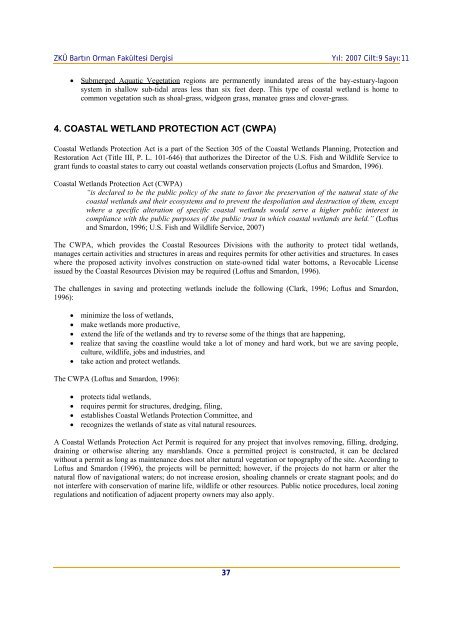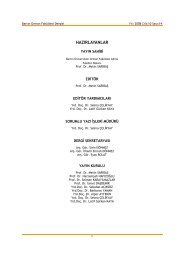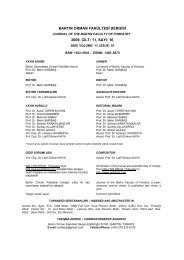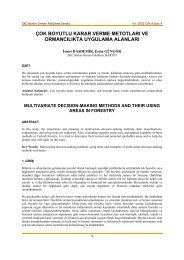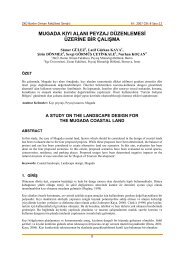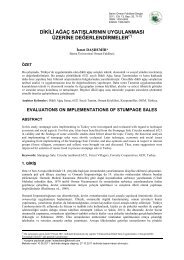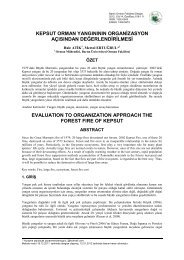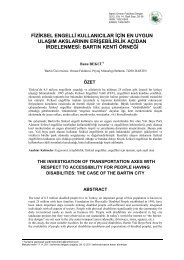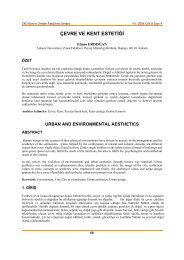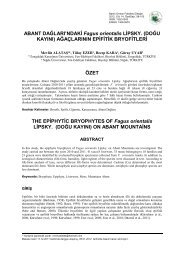ORMAN FAKÜLTESİ DERGİSİ
Tamamını İndir - Orman Fakültesi
Tamamını İndir - Orman Fakültesi
- No tags were found...
Create successful ePaper yourself
Turn your PDF publications into a flip-book with our unique Google optimized e-Paper software.
ZKÜ Bartın Orman Fakültesi Dergisi<br />
Yıl: 2007 Cilt:9 Sayı:11<br />
• Submerged Aquatic Vegetation regions are permanently inundated areas of the bay-estuary-lagoon<br />
system in shallow sub-tidal areas less than six feet deep. This type of coastal wetland is home to<br />
common vegetation such as shoal-grass, widgeon grass, manatee grass and clover-grass.<br />
4. COASTAL WETLAND PROTECTION ACT (CWPA)<br />
Coastal Wetlands Protection Act is a part of the Section 305 of the Coastal Wetlands Planning, Protection and<br />
Restoration Act (Title III, P. L. 101-646) that authorizes the Director of the U.S. Fish and Wildlife Service to<br />
grant funds to coastal states to carry out coastal wetlands conservation projects (Loftus and Smardon, 1996).<br />
Coastal Wetlands Protection Act (CWPA)<br />
“is declared to be the public policy of the state to favor the preservation of the natural state of the<br />
coastal wetlands and their ecosystems and to prevent the despoliation and destruction of them, except<br />
where a specific alteration of specific coastal wetlands would serve a higher public interest in<br />
compliance with the public purposes of the public trust in which coastal wetlands are held.” (Loftus<br />
and Smardon, 1996; U.S. Fish and Wildlife Service, 2007)<br />
The CWPA, which provides the Coastal Resources Divisions with the authority to protect tidal wetlands,<br />
manages certain activities and structures in areas and requires permits for other activities and structures. In cases<br />
where the proposed activity involves construction on state-owned tidal water bottoms, a Revocable License<br />
issued by the Coastal Resources Division may be required (Loftus and Smardon, 1996).<br />
The challenges in saving and protecting wetlands include the following (Clark, 1996; Loftus and Smardon,<br />
1996):<br />
• minimize the loss of wetlands,<br />
• make wetlands more productive,<br />
• extend the life of the wetlands and try to reverse some of the things that are happening,<br />
• realize that saving the coastline would take a lot of money and hard work, but we are saving people,<br />
culture, wildlife, jobs and industries, and<br />
• take action and protect wetlands.<br />
The CWPA (Loftus and Smardon, 1996):<br />
• protects tidal wetlands,<br />
• requires permit for structures, dredging, filing,<br />
• establishes Coastal Wetlands Protection Committee, and<br />
• recognizes the wetlands of state as vital natural resources.<br />
A Coastal Wetlands Protection Act Permit is required for any project that involves removing, filling, dredging,<br />
draining or otherwise altering any marshlands. Once a permitted project is constructed, it can be declared<br />
without a permit as long as maintenance does not alter natural vegetation or topography of the site. According to<br />
Loftus and Smardon (1996), the projects will be permitted; however, if the projects do not harm or alter the<br />
natural flow of navigational waters; do not increase erosion, shoaling channels or create stagnant pools; and do<br />
not interfere with conservation of marine life, wildlife or other resources. Public notice procedures, local zoning<br />
regulations and notification of adjacent property owners may also apply.<br />
37


